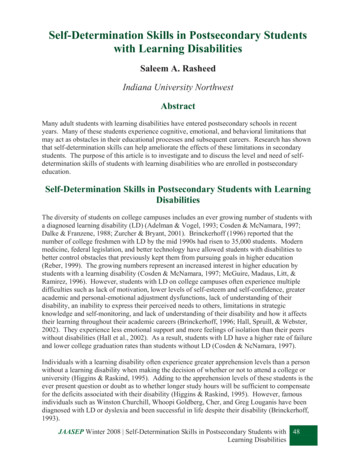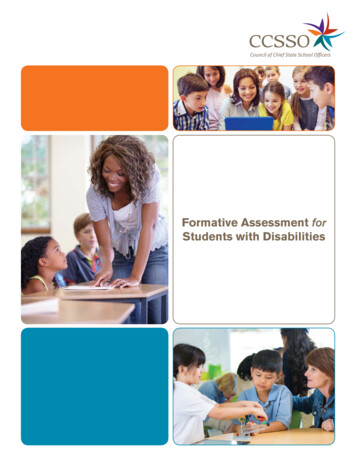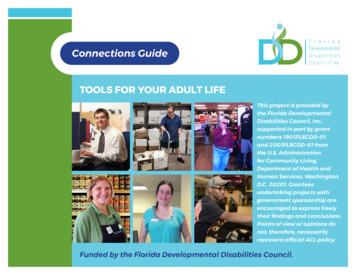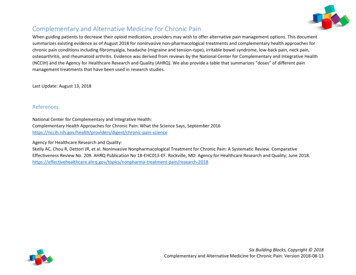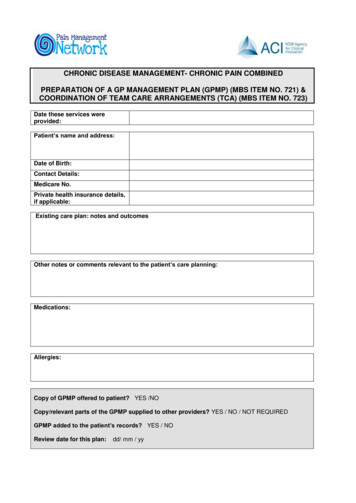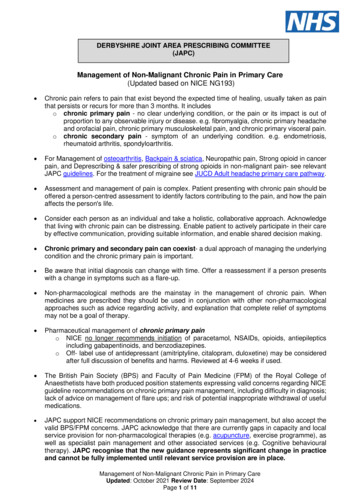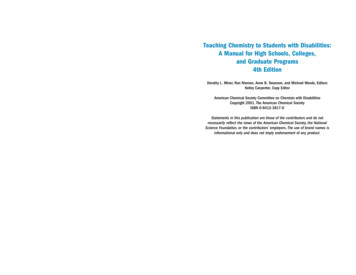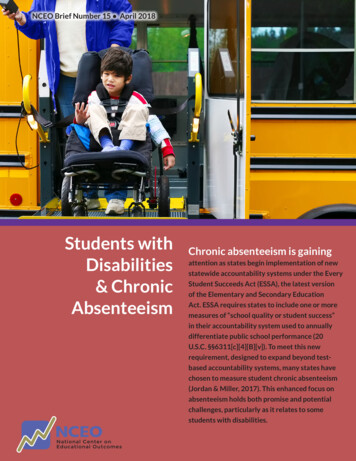
Transcription
NCEO Brief Number 15 April 2018Students withDisabilities& ChronicAbsenteeismChronic absenteeism is gainingattention as states begin implementation of newstatewide accountability systems under the EveryStudent Succeeds Act (ESSA), the latest versionof the Elementary and Secondary EducationAct. ESSA requires states to include one or moremeasures of “school quality or student success”in their accountability system used to annuallydifferentiate public school performance (20U.S.C. §§6311[c][4][B][v]). To meet this newrequirement, designed to expand beyond testbased accountability systems, many states havechosen to measure student chronic absenteeism(Jordan & Miller, 2017). This enhanced focus onabsenteeism holds both promise and potentialchallenges, particularly as it relates to somestudents with disabilities.1
The purpose of this Brief is to provide information aboutchronic absenteeism and possible implications for studentswith disabilities when a state selects it as a measure ofschool quality or student success. It highlights both thebenefits and potential risks in light of requirements in theIndividuals with Disabilities Education Act (IDEA), Section504 of the Rehabilitation Act of 1973 (Section 504), andthe Americans with Disabilities Act (ADA).School districts were required to report the percentageof students in each school who miss 15 or more daysduring the school year as part of the U.S. Department ofEducation’s Civil Rights Data Collection (CRDC) for the firsttime in 2013-2014. ESSA requires this information to beincluded in annual state and local district report cards.The Brief also suggests actions that states might considertaking to address chronic absences among students withdisabilities at the state and local levels as they work toinclude this new measure in accountability systems. Forpurposes of this Brief, students with disabilities are thoseeligible for special education and related services underIDEA.There is a clear relationship between attendance andachievement. In 2016, the U.S. Department of Educationreported that:What Do We Know about Chronic Absenteeism?What is Chronic Absenteeism?Chronic absenteeism is a measure of how many studentsmiss a defined number of school days for any reason—excused, unexcused, suspension. Many states definechronic absenteeism as the number and percentage ofstudents missing 10 percent or more of their school daysin a year. For a typical school year of 180 days, this meansmissing 18 or more days or an average of 2 days permonth. However, the definition, and the number of daysvaries from state to state. Generally, students who arechronically absent include students absent for any reason(e.g., illness, suspension, the need to care for a familymember), regardless of whether the absences are excusedor unexcused. Children who are chronically absent in preschool,kindergarten, and first grade are much less likely toread on grade level by the third grade. Students who cannot read at grade level by the thirdgrade are four times more likely to drop out of highschool. By high school, regular attendance is a better dropoutindicator than test scores. A student who is chronically absent in any yearbetween the eighth and twelfth grade is seven timesmore likely to drop out.The most recent national data available (CRDC, 2013-14),showed that about 14% of students missed 15 or moreschool days. Nearly 10,000 schools reported 30% or moreof students as chronically absent. Elementary schoolsgenerally had lower average rates of chronic absences(11%) than high schools (19%). Schools with higherpercentages of economically disadvantaged students hadSource: Future Ed (2017), analysis of state ESSA plans.2
absenteeism will provide extensive information aboutdisparities across student groups.In addition to chronic absenteeism, other measuresfrequently used by states to measure attendanceinclude: Average daily attendance (ADA), which measuresthe average number of students who show up onany given day, but masks students who are at riskof academic failure due to chronic absences. Truancy rates, which include only unexcusedabsences. Truant students generally face punitiveconsequences such as suspensions, academicsanctions, and with repeat offenses, referral tojuvenile or family courts.Many factors may contribute to higher rates of absencesamong students with disabilities. Among these are chronichealth conditions, fatigue and other side effects frommedication, anxiety caused by bullying and harassment,inappropriate or inadequate special education and relatedservices, trauma, food, and housing insecurity. Manystudents with disabilities also receive developmental andsupportive services and health related services from privatetherapists.To date there is little research to explain the significantgap in chronic absenteeism between students withdisabilities and those without disabilities. Some studentswith disabilities are fragile medically, or may haveemotional or behavioral disabilities that might affectattendance, but there currently is little data available aboutchronic absenteeism and these populations. A nationaldata collection on the characteristics and experiencesof youth in special education (Liscomb, Haimson, Liu,Burghardt, Johnson, & Thurlow, 2017) found a much higheroccurrence of health conditions among special educationstudents. Specifically, it reported that chronic healthconditions were nearly three times more common amongyouth with an Individualized Education Program (IEP) thanamong those without an IEP. Twenty-eight percent ofyouth with an IEP had a chronic physical or mental healthcondition that required regular treatment or medical careaccording to parents, compared with 10% of their peers.The report also included that youth with an IEP weremore likely than their peers to have poorer health, chronicconditions, and behavioral issues that need to be controlledmedically.more chronic absenteeism than other schools. AmericanIndian or Alaska Native, Native Hawaiian or other PacificIslander, Black, multiracial, and Latino students had higherrates of chronic absenteeism than other students at boththe elementary and high school levels.All of these reported 2013-14 rates may have beenunderreported because it was the first time schools wererequired to report on absenteeism; some schools mayhave not understood how to appropriately report thesedata at that time. Further, it is possible that the chronicabsenteeism rate has increased since 2013-14; we do nothave national data to help us understand whether theserates are increasing or decreasing.What Do We Know about Chronic Absenteeism AmongStudents with Disabilities?The 2013-14 national data showed that elementaryschool students with disabilities served by IDEA were1.5 times as likely to be chronically absent as elementaryschool students without disabilities. High school studentswith disabilities served by IDEA were 1.4 times as likelyto be chronically absent as high school students withoutdisabilities. Across subgroups, only Native students(American Indian or Alaska Native and Native Hawaiianor other Pacific Islander) exceeded the rates of chronicabsenteeism for students with disabilities.One recent study looked at the variation in elementaryschool students with disabilities across five IDEA disabilitycategories (Gottfried, Stiefel, Schwartz, & Hopkins, 2017).The study found students with emotional disturbancewere more than 13 percentage points more likely to bechronically absent than general education students in thesame classrooms. Students with a learning disability were7.6 percentage points more likely to be chronically absentthan their peers without disabilities, while students withother health impairments or low incidence classifications(e.g., deaf/hard of hearing) were 5.6 and 6.5 percentagepoints more likely, respectively, than their peers withoutThis disparity is echoed in more recent data collectedby states. For example, Connecticut’s (2017) data forthe 2015-2016 school year showed that studentswith disabilities served by IDEA continued to exhibitsubstantially higher chronic absenteeism rates than theirgeneral education peers despite statewide prevention andintervention efforts. Eighteen percent of Connecticut’sstudents with disabilities were chronically absent comparedto 9.6 percent overall.According to the 2013-14 CDRC:ESSA requires states to disaggregate all measuresused in statewide accountability systems by studentsubgroups (major racial and ethnic groups, economicallydisadvantaged, students with disabilities, and Englishlearners). Thus, new (more recent) data on chronic 16% of students who missed 15 or more schooldays were students with Individualized EducationPrograms (IEPs). 18.5% of students with disabilities (1.1 million)missed 15 or more school days.These data indicate that students with disabilities misseda minimum of 17 million days of instruction.3
Increased Graduation Rates. ESSA also requires all statesto establish long-term goals for improving the 4-yeargraduation rate for all student subgroups. DePaoli,Balfanz, Bridgeland, Atwell, and Ingram (2017) found thatthe nation’s 4-year graduation rate gap in 2014-15 (themost recent data available nationally) for students withdisabilities stood at 21.1 percentage points. In 29 states,students in the general education population graduated atrates that were at least 20 percentage points higher thanthe rates of their special education peers. In another 18states, the gap between students with disabilities and thosewithout disabilities was between 10 and 20 percentagepoints. In only three states was the graduation rate gapless than 10 percentage points. The relationship betweenattendance and graduation is well established (U.S.Department of Education, 2016), so closing these gaps willrequire significant improvement in chronic absences amongstudents with disabilities.disabilities. Only students with speech or languageImpairments were less likely than their peers withoutdisabilities in the same classrooms (0.7 percentage points)to be chronically absent.Gottfried et al. (2017) also analyzed chronic absenteeismrates between students with disabilities served inclassrooms that had mostly general education studentsversus classrooms that had mostly special educationstudents. Students with disabilities served in classroomswith mostly special education students were 16.7percentage points more likely to be chronically absentthan general education students in those same classrooms,while those served in classrooms with mostly generaleducation students were only 4.9 percentage points morelikely to be chronically absent than their general educationpeers in those same classrooms. This analysis also foundthat among students with disabilities, those with emotionaldisturbance served in settings that were composed mostlyof special education students were the most likely to bechronically absent—approximately 24 percentage pointsmore likely than general education students.Reduced Use of Suspension. Because days missed dueto suspensions are counted in the calculation of chronicabsenteeism, the disproportionate use of out-of-schoolsuspension of students with disabilities reflected inCRDC 2013-14 must be addressed. The 2013-2014 dataindicated that students with disabilities were more thantwice as likely (12%) to receive one or more out-of-schoolsuspensions as students without disabilities (5%).Potential Benefits of Increased Attention to ChronicAbsenteeism for Students with DisabilitiesThe increased focus on chronic absenteeism brought aboutby its inclusion in many state accountability plans holdsseveral potential benefits. States, districts, and schoolsmay want to consider ways to ensure that these benefitsare realized.A report from the Civil Rights Project (2015) found that 5%of elementary school students with disabilities and 18% ofsecondary school students with disabilities were suspendedat least once during the 2011-2012 school year. Theserates were substantially higher for minority students withdisabilities.Fairer Attendance Policies. Attendance policies are likely tobe created, or reviewed and possibly revised in conjunctionwith states’ chronic absenteeism measure in ESSA. Thesepolicies should include information specific to studentswith disabilities, including how to handle absences arisingfrom a student’s disability that are included in the student’sIEP as well as absences related to receipt of privateservices and therapies. These policies might identifyschool and district legal responsibilities under federal andstate laws to protect personally identifiable informationin a student‘s education and health records that may berelevant to their chronic absenteeism. They also mightinclude plans for governing provision of supplementalmake up instruction.Reduced Dropout Rate. Students with disabilitiesexperience much higher rates of dropout than their peerswithout disabilities. The dropout rate of 16- to 24-yearolds with disabilities in 2013 (14.9 percent) was abouttwice as large as the rate for their peers without disabilitiesthat year (National Center for Education Statistics, 2016).1When students are better monitored with respect toexcessive absences and truancy, schools can identify moreeasily those students at risk.Potential Risks of Increased Attention to ChronicAbsenteeism for Students with DisabilitiesImproved Academic Achievement. ESSA requires allstates to establish long-term goals for improved academicachievement, as measured by proficiency on annual stateassessments in reading/language arts and mathematics, foreach student subgroup, including students with disabilities.These goals are to result in significant progress in closingproficiency gaps. Students with disabilities are consistentlyone of the lowest performing groups of students on stateassessments, and their significant gaps have been slowto close (Thurlow, Albus, & Lazarus, 2017). Achieving theambitious proficiency levels proposed by states will requireattention to all aspects of serving students with disabilities,including addressing chronic absenteeism which has thepotential to support improved learning and achievement.Increased focus on chronic absenteeism also holds severalpotential risks for students with disabilities. Schools,districts, and states should consider these risks as theyimplement policies and practices, taking particular care toavoid harm to students.Personalizing chronic absenteeism to focus on individualchildren rather than the system. For many students whoexperience chronic absenteeism the line between excusedand unexcused absences is blurred. These include fosterThis dropout rate is a “status” rate. It reflects the percentage of allyouth ages 16-24 who were not enrolled in school and who hadnot earned a high school diploma during the year.14
children, those who are homeless, transient, mobile,and students with disabilities associated with chronicillness or physical, emotional, and mental health relatedmanifestations. To the degree districts and schools makechronic absenteeism an accountability metric that does notaddress the system, but instead blames students, it mayhave the effect of further isolating and adversely affectingstudents who are among the most vulnerable. An exampleof blaming the student would be excluding the student fromthe general classroom in an attempt to improve the chronicabsenteeism rate.system for skipping school is ineffective, and harshpunitive programs do not reduce truancy rates (TexasAppleseed, 2015).Challenging or diminishing the value of parental judgment.To the extent schools and districts perceive ”chronicabsenteeism” as a high-stakes measure that results inapplying a “one size fits all” standard, parents may wellfind their judgment being second-guessed or worse (suchas referrals to departments of children and families, familycourt, juvenile court) and perceive their judgment as notvalued. Parental judgment, though not beyond reproach,is entitled to respect based on personal knowledge,experience, and understanding of their child and how thatchild is functioning in school. On a daily basis, parentsand guardians of students with disabilities, in particularthose whose disabilities may be chronic or episodic (e.g.,in response to medication) or accompanied by physical oremotional manifestations, make judgments about whatthey believe is best for their child.Through schoolwide initiatives designed to improvechronic absenteeism, it is likely that members of the schoolcommunity will become more knowledgeable about therelationship between attendance and achievement (Che etal., 2015; Gottfried, 2010; U.S. Department of Education,2016b). They might group children based on attendance tomitigate the adverse impact of chronically absent studentson the education and achievement of their regularlyattending classmates (i.e., repeating instruction, slowingdown progress of others) (Gottfried 2011; Gottfried 2014).Recommended ActionsThere are several actions that states should considertaking if they are using chronic absenteeism as a measurein their accountability systems. These actions also will bebeneficial to states that have not opted to use chronicabsenteeism as their measure of school quality or studentsuccess. These actions include:Setting unrealistic goals that encourage push-outs and deenrollment of certain students. The manner in which thechronic absenteeism indicator is implemented is critical. A“one size fits all” definition, with implicit bias that targetschildren based on race, ethnicity, poverty, language status,and disability should be avoided. Similarly, subjectivedecisions by school personnel that relate to schooldiscipline and disparately affect certain students or thatchallenge the value of parental judgments about the needto miss school should be questioned.Develop a clear definition of “chronic absenteeism.”Ensure that the definition is shared with districts andschools. Further, require districts and schools to providethe definition in multiple places available to parents andstudents.Instituting punitive responses to truancy. Most stateshave laws that authorize, and in some cases require,school districts to refer to juvenile or family courts thosestudents who are of compulsory school age and are notattending school (Education Commission of the States,2011). States’ compulsory attendance laws that establishthe ages between which children and youth are requiredto attend school vary, as do the types of sanctions that areauthorized when students fail to attend school. Similarly,the number of unexcused absences a student can accruebefore being considered “truant” or a “habitual truant”and subject to sanctions varies across states (EducationCommission of the States, 2011).Consider the “stakes” of the metric for “chronicabsenteeism” for schools or students. Develop state policyand procedures that encourage effective interventions forassisting individual students who are vulnerable to chronicabsences and, as necessary, schools and districts withhigh rates of chronic absenteeism. Consider policies andprocedures that limit privileges (e.g., open campus, flexiblestart time) instead of using sanctions that interfere withinstruction (e.g., disenrolling students or isolating studentsvulnerable to chronic absences in alternative schools orclasses segregated from the general curriculum) or mayencourage unintended consequences (e.g., increased pushouts, dropouts, or involvement with the juvenile justicesystem).Status offenses are offenses that are not crimes for adults,but are for children based on their status as children. Theyinclude truancy and running away, for example. The listof status offenses varies by state, and depending on statelaw may result in a child being adjudicated and punishedin a manner similar to a delinquent and often exposedto the juvenile justice system. Sometimes status offensecases are treated as dependency cases (with parents orguardians held responsible), while other states treat themas delinquency cases (Curtis, 2014). These approachescontinue despite the strong research indicating thatisolating and referring children to the juvenile justiceMake communication with parents a priority. Statesshould consider developing policies and proceduresthat encourage schools to initiate early and frequentcommunication with the student’s parents about absences.For example, a state may want to consider developing apolicy that requires schools to have a conversation witha parent when any child reaches a specific number ofconsecutive or total absences or has exhibited a pattern ofabsences prior to triggering consequences. Also, use themost convenient method of communication for the parent.5
States may also want to indicate that schools propose a reevaluation of a student to help uncover causes of absences.Remind schools that if parents are unavailable for a timelyface-to-face meeting, they should consider meeting viaphone or video conference. Absences directly related toa student’s disability, such as anxiety or depression thatlead to school refusal, should trigger a quick response.Students may need a behavior intervention plan orattendance incentives to overcome issues that interferewith attendance. Especially at the high school levelwhere rates of absenteeism increase, involve students indeveloping solutions and strategies for reducing absencesand improving the climate at the school so that they wantto be there.The latest data from the Speak Up Research Projectprovides insights on school-to-home communications.For communications about individual children, parentsfavored email, with text messages second. The preferencefor texting did not change based on demographics likecommunity type, poverty level, or education level. In fact,95 percent of the parents surveyed said they had some kindof smartphone.Encourage districts and schools to discover the rootcause of absenteeism. Provide professional developmentto districts and schools on ways to determine whetherabsences are related to the child’s disability or otherfactors that may need to be accommodated (e.g., lackof winter clothing, transportation, permanent housing).Develop state policies that encourage collaboration amongschools, parents, appropriate community organizations,and homeless liaisons when relevant, to address students’comprehensive needs. Work with districts and schools toformulate specific procedures to be followed when a child’sabsenteeism is related to the child’s disability. If otherfactors are interfering with attendance, encourage districtsand schools to consider referring the student to a schoolcounselor who might be able to connect with the broadercommunity network for support.Provide a clear message to districts and schools thatthey should provide services to compensate for lostinstructional time. Schools and districts should quicklyarrange to provide services that will compensate for theinstructional time being lost due to excessive absences.A policy that automatically triggers a review of changes inservice provision may help avoid potential disputes andorders for corrective action. Providing homebound servicesfor a period of time will likely require a change of placementdocumented in the student’s IEP.Monitor schools and districts’ heightened use of in-schoolsuspensions as an alternative to out-of-school suspensionsas a way to reduce the rate of chronic absenteeism. Thisshift will require monitoring because the implementation ofin-school suspensions varies widely within and across statesand school districts. While some districts educate childrenserving in-school suspensions, others do not. Therefore,in-school suspension may still remove the student frominstruction.Examine data at deep levels. Given the heterogeneity ofstudents with disabilities as well as the variance in the waythese students are served across our nation’s schools, thefindings of the Gottfried et al. ( 2017) study emphasizethe importance of examining data on student absencesat the disability category level as well as by the setting inwhich students with disabilities are being served. Suchdata analyses can assist districts and schools in addressingchronic absenteeism among students with disabilities.Identify for consideration and adoption provendropout prevention programs that benefit studentswith disabilities. Studies indicate that improved truancyreporting significantly reduces school dropout by 5percentage points (De Witte & Csillag, 2014). Severalevidence-based dropout prevention programs also havebeen recognized by the What Works Clearinghouse(Dynarski, Clarke, Cobb, Finn, Rumberger, & Smink, 2008;Rumberger et al., 2017).Recommend that schools consider the need for an IEPmeeting when absences are clearly connected to thestudent’s disability. Provide information for schools thatencourages them to act quickly to address the issue withparents and to convene an IEP meeting to amend the IEP toadd or revise attendance information.Chronic health conditions that interfere with schoolattendance should be well documented in the student’sIEP. Documentation should include how the student will beprovided with services during periods of extended absence.Care should be taken to ensure that services are providedby qualified personnel and to the extent necessary to keeppace with IEP goals. Failure to act in a timely manner couldmake the district vulnerable to a dispute. IDEA’s federalregulations require that a district revise a student’s IEP toaddress any lack of expected progress toward the annualgoals described in the IEP and in the general educationcurriculum, if appropriate (34 C.F.R. §300.320(a)(3)). Whenabsences are interfering with progress, districts should takesteps to address the lack of progress. To do otherwise mayresult in a determination of denial of a free appropriatepublic education.Implement enhanced attention to chronic absenteeismcarefully, ethically, and professionally to improve studentattendance and learning opportunities, to increaseacademic performance, to reduce the likelihood of droppingout of school, and to increase the likelihood of earning ahigh school diploma. States should take care in setting goalsthat are ambitious but not so unattainable that they canonly be accomplished by districts and schools deciding topush out and de-enroll the most vulnerable students bytracking “unexcused absences” and diverting them into thestate’s family court or juvenile court system for violatingcompulsory education requirements (Schanzenbach et al.,2016).6
Provide guidance, oversight, and professional developmentopportunities to ensure that district and school personnelare aware of the requirements limiting non-consensualaccess and disclosure of personally identifiable information,including physical and mental health related information,and sensitive information about family status and services,contained in a student’s education and medical records.Clarify that schools may not seek blanket releases fromparents seeking information about children’s absences fromdoctors, therapists or other service providers under thefederal privacy statutes governing education records andmedical records, namely the Family Educational Rights andPrivacy Act (FERPA) and the Health Insurance Portabilityand Accountability Act (HIPAA) and relevant state laws.Curtis, A. J. (2014). Tracing the school-to-prison pipeline from zerotolerance policies to juvenile justice dispositions, 102 GeorgetownLaw Journal 1251. ng-school-to-prison-pipeline-fromDe Witte, K., & Csillag, M. (2014). Does anybody notice? Onthe impact of improved truancy reporting on school dropout.Education Economics, 22(6). 92.2012.672555Dynarski, M., Clarke, L., Cobb, B., Finn, J., Rumberger, R., & Smink,J. (2008). Dropout prevention: A practice guide (NCEE 2008–4025). Washington, DC: National Center for Education Evaluationand Regional Assistance, Institute of Education Sciences, U.S.Department of Education. Retrieved from http://ies.ed.gov/ncee/wwc.Education Commission of the States. (2011). Truancy and habitualtruancy examples of state definitions. Updated by Dinah FreyDenver, CO: Author.Require that schools document all efforts to addressabsenteeism. Schools should be required to maintaindocumentation of all attempts to convene IEP meetings,undertake re-evaluations, and provide effectiveinterventions to mitigate loss of learning opportunities. Awell-maintained record of a school’s attempts to interveneearly and often can be helpful should disputes arise.Frey, D. (2011, March). StateNote, State policy approaches toreducing truancy. Education Commission of the States.Goodman, J. (2014). Flaking out: Student absences and snowdays as disruptions of instructional time. Working Paper No.20221, National Bureau of Economic Research, Cambridge, ons schoolaccountability essa.pdfAdditional Resources on Chronic AbsenteeismChronic absenteeism and students with disabilities:Health status of students with disabilities: Impact onattendance by K. B. Boundy, Esq., & C. Cortiella.Available at eeismHealthIssuesSWD.pdfGottfried, M., Stiefel, L., Schwartz, A.E., & Hopkins, B., Showing up:Disparities in chronic absenteeism between students with and withoutdisabilities. Institute for Education and Social Policy Working Paper#03-17 June 2017.Gottfried, M. A. (2010). Evaluating the relationship betweenstudent attendance and achievement in urban elementary andmiddle schools: An instrumental variables approach. AmericanEducational Research Journal, 47(2), 434–65.Chronic absenteeism: Recognizing child findobligations by K. B. Boundy, Esq., & C. Cortiella.Available eeismChildFindObligations.pdfGottfried, M. A. (2011). Absent peers in elementary years:The negative classroom eff
or other Pacific Islander) exceeded the rates of chronic absenteeism for students with disabilities. This disparity is echoed in more recent data collected by states. For example, Connecticut's (2017) data for the 2015-2016 school year showed that students with disabilities served by IDEA continued to exhibit
